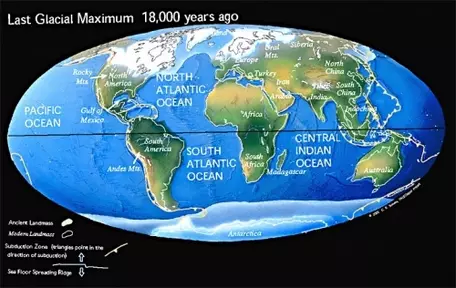Activity: Last Glacial Maximum - CLEAN
Summary
SUMMARY
Activity takes two class periods. Computers with Internet access required.
In this activity for undergraduates, students explore the CLIMAP (Climate: Long-Range Investigation, Mapping and Prediction) model results for differences between the modern and the Last Glacial Maximum (LGM) and discover the how climate and vegetation may have changed in different regions of the Earth based on scientific data.
Learning Goals
Goals by activity author:
- This set of animations and interactive simulations from the Byrd Polar Research Center at Ohio State University help students develop an understanding models used to understand the Earth System.
- Students consider the types of data that need to be included in a climate model, looking at inputs and outputs as well as variables, such as land surface, and how to measure changes of different parts of the Earth's surface over time.
Context for Use
Teaching Notes / Context For Use by CLEAN Reviewers:
Teaching Tips
- Lesson should start with an introduction to the model that was used in the CLIMAP study.
About the Science
- Engages learners in critical scientific thought by discussing the assumptions made in the CLIMAP study in 1976 and 1984 compared to what we know now about climate change since the Last Glacial Maximum (LGM).
- Model output data is somewhat dated, but because it is focused on paleoclimatic data it still provides valid information about the climatic conditions during the last glacial maximum.
- Passed initial science review - expert science review pending.
About the Pedagogy
- Skimming scientific papers, graphing data on maps and interpretation of maps/data engages students of different learning styles.
- Group work or jigsaw approach will be very effective.
- PowerPoint and student handout are provided. Follow-up questions are suggested.
- This resource engages students in using scientific data.
See other data-rich activities
Technical Details/Ease of Use
- Well-designed and relevant materials available. Only background reading is not provided digitally.
Description and Teaching Materials
Explore >> Last Glacial Maximum
Teaching Notes and Tips
Teaching Notes / Context For Use by CLEAN Reviewers:
Teaching Tips
- Lesson should start with an introduction to the model that was used in the CLIMAP study.
About the Science
- Engages learners in critical scientific thought by discussing the assumptions made in the CLIMAP study in 1976 and 1984 compared to what we know now about climate change since the Last Glacial Maximum (LGM).
- Model output data is somewhat dated, but because it is focused on paleoclimatic data it still provides valid information about the climatic conditions during the last glacial maximum.
- Passed initial science review - expert science review pending.
About the Pedagogy
- Skimming scientific papers, graphing data on maps and interpretation of maps/data engages students of different learning styles.
- Group work or jigsaw approach will be very effective.
- PowerPoint and student handout are provided. Follow-up questions are suggested.
- This resource engages students in using scientific data.
See other data-rich activities
Technical Details/Ease of Use
- Well-designed and relevant materials available. Only background reading is not provided digitally.
Assessment
Assessment by activity author:
Assignment or exam question: Ask the students to compare their results from the model output exercise with those described in the CLIMAP papers and in the textbook.
Assignment or take home exam question: Ask students how they would redesign the CLIMAP study base on what we know today about the LGM? What different assumptions would they use and what variables would they examine in order to further the state of knowledge of glacial to modern climate change.
References and Resources
Related URLs: These related sites were noted by our reviewers but not been reviewed by CLEAN
- http://www.ngdc.noaa.gov/mgg/geology/climap18.html
- 1976 Science paper not freely available to general public but is free to AAAS members and most educational institutions at: http://www.sciencemag.org/content/191/4232/1131.abstract
- PDF is at: courses.washington.edu/proxies/CLIMAP-Ice_Age_Earth_Surface-Sci76.pdf
- 1984 paper not freely available but most educational institutions can get it through ScienceDirect at: http://www.sciencedirect.com/science/article/pii/003358948490098X
- 1988 Science article in PDF: http://www.sciencemag.org/site/feature/data/earthdynamics/se3488001043.pdf


![[creative commons]](/images/creativecommons_16.png)
